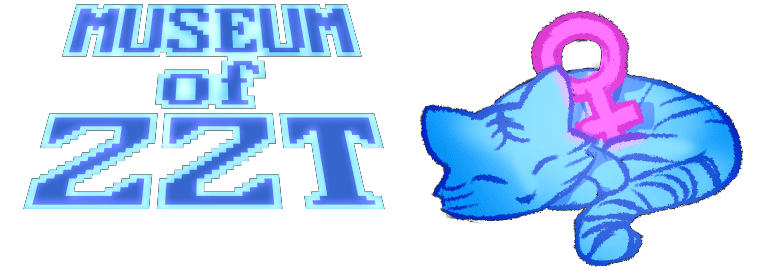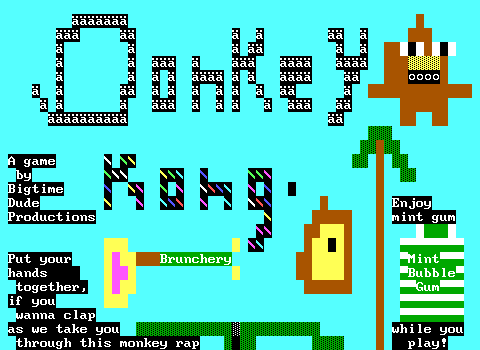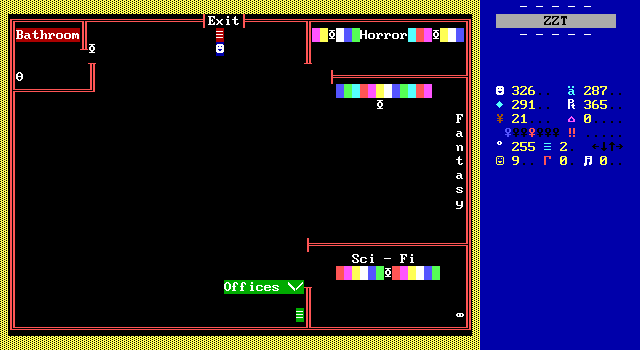
What's your favorite thing about libraries?
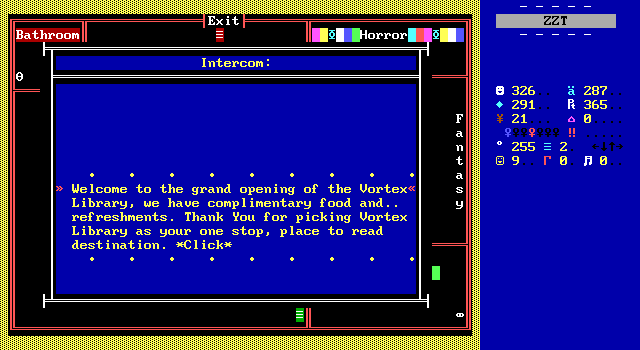
For Captain Cosmo, it's gotta be the loudspeakers that blare loud announcements for everyone in the building to hear!
This is undoubtedly the weirdest library I've ever seen in a game period. Why is there an intercom? This is such a fundamental misunderstanding of what a library is.
The book selection also leaves quite a bit to be desired. It's a sad instance of a library with almost no titles to peruse. A few scrolls are placed to give you titles, though they sound more like generic books that could be real rather than any opportunities for gags or world building or actual book recommendations from the author. If anything, they're more of an insight into the kind of books Sagen dislikes, with "Blood Suckers from Mars" letting you read a paragraph of horror in which it feels like every sentence should be punctuated with an eye roll.
The fantasy shelf isn't even filled in! The scroll says there will be reading material in the full version.
The bathroom is out of order, and everything else is complete blank, so there's nothing much to do other than head to the offices located in the building? I don't know, there's probably such a place in a big city where the first floor is a library and the upper levels are something else, but I certainly wasn't expecting it in what seems like such a small town.
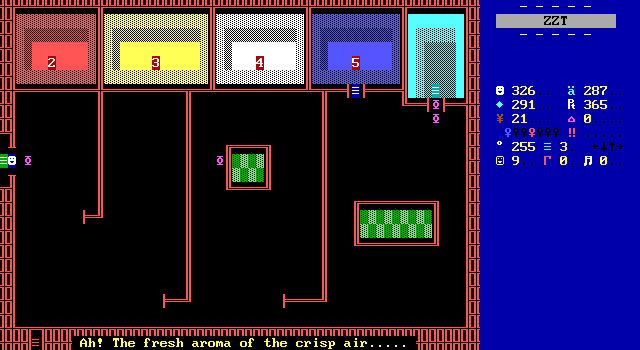
I really hesitate to use the phrase "liminal space", but something about the office board here, with just its rows of doors and the tiniest little plants gives off a vibe to me that's far more powerful than anything else in the game. Something about wandering the halls of an deserted office building that wants to look welcoming, but can only ever feel empty. It reminds me of the dentist I went to in my hometown before he got his own building. Walking down a long hallway to open a single door, passing a whole bunch of other rooms whose contents and purpose were unknown. An interior that would be no different if 95% of the doors weren't there at all.
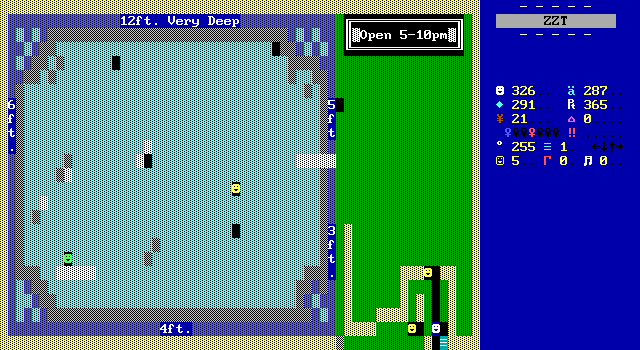
The backrooms thing is made all the funnier since one of the two "offices" you can enter is actually just a public pool!
As far as ZZT pools go, this one isn't half bad. I like the labels of different depths, and love the beach ball that floats around for a bit before disappearing. You can head into the pool yourself by walking off the diving board. It's also one of the game's more animated boards. It doesn't amount to a whole lot, the two swimmers and ball both #WALK in a single direction and stop or disappear once they hit the edge, so the scene eventually stops having any movement.
It's also another superfluous board with no information, items, or anything helpful to uncover. I think Sagen just wanted to make a pool scene. He just decided to put it in an office in a library. (A scroll even comments on how weird it is for a pool to be here.) "He just wanted to" seems to be the basis of the majority of boards in the game really.
The pool also seems like a test bed of interactions. One attendant is taking donations to help keep the pool afloat (not sorry) which lets Cosmo choose whether or not to make a 40 gem donation, or alternatively to just give the lady a pack of chewing gum that he's apparently had on him this whole time.
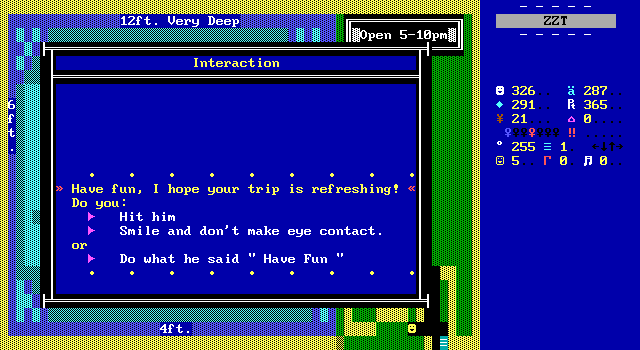
Meanwhile the other attendant has some more interesting options, covering "smile" and "hit". It's quite the swimming pool.
As superfluous to the kidnapping plot most locations in the game are, the library does have one purpose. As announced by the intercom, Cosmo has been summoned to the office of Mr. Nonsanse. This is where the demo comes to a close, with one last bit of story exposition before the game tells you to get version 1.2 if you want to see the rest of the game.
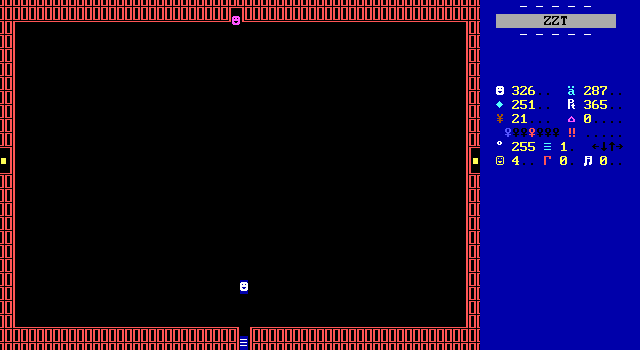
The kidnapping has been brought up, but her mutation into an alien is news. As is the name Jaque` Coo Stu as the kidnapper, giving somebody else to go after than Mr. Jack Jorz. There's no real time to ruminate on the story though, as the game ends as soon as the message window is closed, even though the open-ended design means players probably have more areas to investigate still.
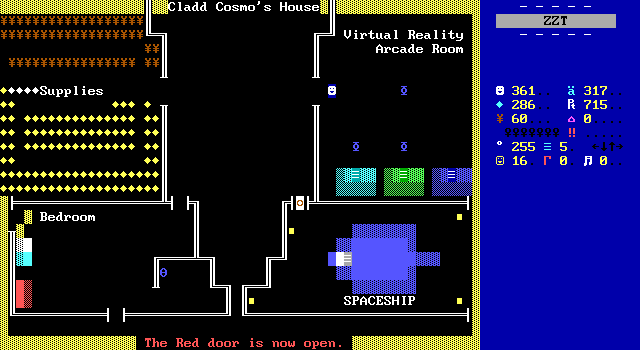
In my case, the only area left was to return to Cosmo's home and use a key to finally check out the VR arcade. By this point expectations of what this could be were fairly low. Sagen has demonstrated an ability to make some cute locations. What he hasn't demonstrated, is the ability to make anything slightly complex. The mini-games one might expect of ZZT arcades, won't be found here.
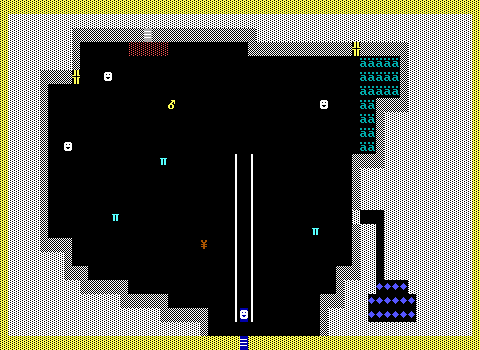
Instead, you get regular ZZT gameplay as mini-game. "The Cave of Confusion" is just a single dark board with some enemies to shoot at. The second passage is blocked off, but easily accessed by shooting the surrounding walls where a second incomplete board will halt the game.
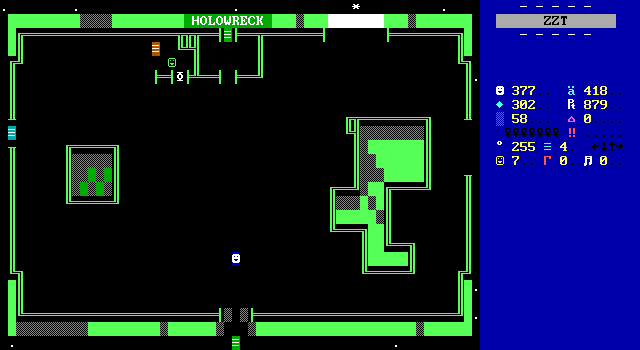
The second, brings you to the Virtual Space Station which has nothing but a virtual bartender that gives you a ticket to redeem in the full version of the game, so there's nothing of note here either. Annoyingly, only one of the three new exits is blocked off, but all three lead to incomplete boards that trap the player there. I suppose it's a saving grace that you can't get to the arcade right away so your game won't come to a sudden end moments after press "P" on the title screen. (...Well, more on that soon enough.)
The third, is also locked up behind a full version with another empty board on the other end of its passage. The board is titled "Space Dungeon" as a tiny hint of what may have been.
The last place to explore is Cosmo's own ship. It too is deliberately blocked off, with both a wall in front of the ship's passage as well as requiring a key that isn't present in the game to reach. Still, with how many unused boards have something built on them, I held out hope that maybe I'd get a better idea of what the game was to be like once you left this starting town.
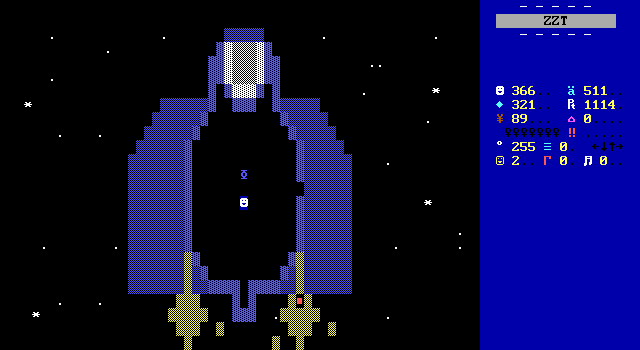
Maybe it's a bit unfair to judge an incomplete board's visuals. Even so, the ship's interior isn't the most impressive. It does at least read as a spaceship, with an effort made at conveying movement. There are no scrolling stars here, only a botched attempt at animating thrusters which change from red to yellow, and then never change back to red. At least it looks like Cosmo is off in search of the mayor's wife, reluctant as he may be to have received his promotion.
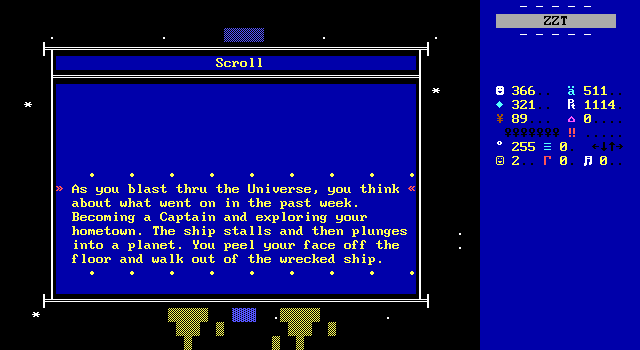
The game (for me) ended here, in this empty vessel with a scroll that did in fact hint at what was meant to come for Cosmo in a full version or perhaps second chapter. Cosmo reminisces on the events of the past week which have upended his life. An unwanted promotion, a foisting of new responsibilities, being forced to rescue someone in order to save his own family. A lot of people are friendly to Cosmo, but here he is, alone with no support.
And of course, to make matters worse, the setup for the next segment of the game is revealed as your ship suffers a malfunction and crash lands on a nearby planet. Cosmo's rough week is about to become even more miserable.
And that's where the game stops if you really go digging for inaccessible content. It left me wondering why Sagen opted to end the game with Mr. Nonsance where the sudden stop occurs at an unnatural feeling breaking point. Have Nonsance give players the key to reach Cosmo's ship, and you'd have proper closure, with a much better hook for whatever was intended to come next.
The Parts That Suck
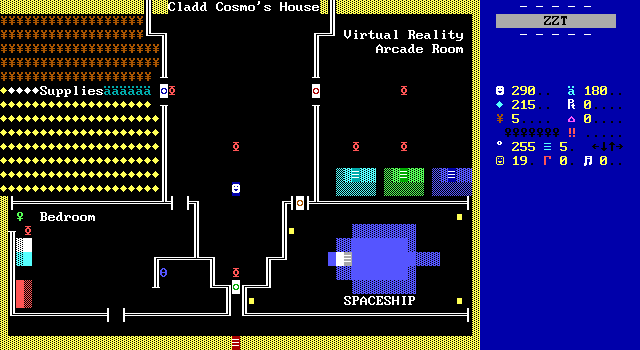
When I said Sagen has some "opportunities" for improvement in the intro, well, the starting board speaks for itself.

Okay, actually this is the starting board. The game is one of oh so many that accidentally saves itself on the wrong board, in this case, the final screen of the demo. At least the error makes itself apparent quickly when the first person you talk to says to keep an eye out for the full version.
Really though, the actual starting board makes the game look a lot worse than it's going to be. This ticks off a number of (subjective) boxes found in guides on what not to do in your ZZT game in worlds like ZZT Syndromes. We've got the obligatory yellow borders, the piles of items, and the far more contentious over-labeling of things.
Folks seem to have come around on these excessive text labels that tell you what you're looking at rather than let you discover that by exploring, or ideally by simply being able to recognize what you're looking at. I don't really object to them in older titles, or newer titles that are trying to give off the appearance of older ones, but if I am playing a game called Captain Cosmo and I can only tell I'm looking at a space ship because you wrote SPACESHIP then I feel like you may have made a mistake somewhere.
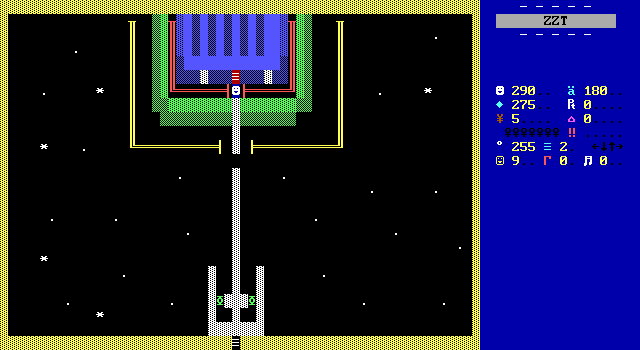
At this point, I've been inundated with yellow borders often enough that I know better than to immediately disregard everything a game has to offer solely because the author didn't clean their edges. There is just a single exception to me, where I just cannot stand them, seen here.
This is space. We are looking at outer space. Space is famous for not having a border. I cannot see boards like this as being space. Somebody just sprinkled salt all over a perfectly good board.
The yellow borders seen throughout Captain Cosmo are sporadic. Sometimes they're removed, sometimes they're used as a border, and sometimes there's a border within a border drawn just to really cover all the bases! Maybe they make the world a bit less pretty, but how much does that really matter? It's an aesthetic issue that doesn't actually hurt the game in any meaningful way.
What is rather annoying is that Sagen here has yet to get a hold on how ZZT-OOP is programmed. I've seen my share of games by now where the author doesn't realize that code will automatically run, leading to a barrage of messages upon entering any board with dialog. Sagen just seems forgetful. On some boards, everything operates as intended. Touch a sign to read a sign. Touch a person to talk to them. But on a lot of them, you get auto-firing text that appears almost as soon as you enter the board.
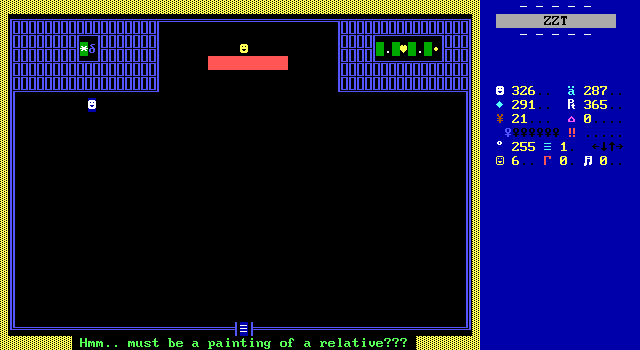
This is at its worst in the mayor's home where Cosmo learns of his quest. One object holds Cosmo's line, while two are used for the mayor's. A few games go so far as to break up dialog per-character just to have the object's name at the top always reflect who is speaking, as seen in- [I'm going insane trying to find an example. I know I suffered compositing conversations into transcripts for an article before]. Most authors don't bother, as complex conversations mean constantly closing message windows so the next one can open rather than just letting you scroll to keep reading. The author gets stuck with extra work juggling #SEND commands and making it harder to find specific text if something needs to be edited later. By now, so many ZZT games opted not to do dialog this way, that even if message windows are opening and closing repeatedly, it's easy to not glance back up at the object name to find out who is speaking if it's changed, and if you label the text with the speaker's name, then why bother splitting it up all?
Worst of all I get the extra work if I need to present a conversation in this format in one of these articles, inserting a dozen clipped screenshots or manually stitching the raw text together in a scroll transcript. So I say, don't bother.
But here the problem is stranger. There is no use of #SEND to arrange the conversation. Sagen relies on the objects firing one at a time in order, allowing the mayor to speak (via object one), Cosmo to respond (object two), and the mayor to reveal why Cosmo will be going on the rescue mission regardless (object three). This isn't actually that bad of a plan these days. You could map an entire conversation like this with a row of objects going across the screen that blend into the scenery making it easier to find a specific object when editing. Yet I've never seen anyone do it like that before.
And there's a reason for that! A reason which even Cosmo's three object conversation is enough to demonstrate. It's easy to forget these days with third party editors that make it easy to to pre-set objects to cycle one or outright make it the default to begin with. In ZZT's own editor though, objects begin at cycle three and have to wait for their first active cycle to switch to a faster one. This does not mean that you enter the board, wait until the third cycle, and then the three cycle three objects spit out their lines. ZZT staggers higher-cycle elements not just based on the game tick, but also the index of the stat being ticked.
If you have three cycle three objects, one will run code on the first tick, another on the second, and the third on the third. It all works great if you enter the board on the first tick, but going through passages randomizes this value. A single line in the Reconstruction of ZZT is responsible:
if (Cycle <> 0) and ((CurrentTick mod Cycle) = (CurrentStatTicked mod Cycle)) then
What it all means is that the three objects that make up this conversation will display in an inconsistent order! If you make a save just before stepping into the mayor's home, you can quickly see a number of arrangements of the conversation, of which only the intended order makes any sense.
The lack of of a #END to restrain certain messages also shows up when dealing with certain hyperlinks. It's not uncommon to interact with something, see a list of options to choose, and directly below see the outcome of at least one of those options. Captain Cosmo doesn't do anything too mean with its choices. You will cut yourself shaving perhaps, but you can rest easy knowing that you won't be killed for touching something and choosing "cut the yellow wire" without having any input. And even the shaving injury doesn't take any health.
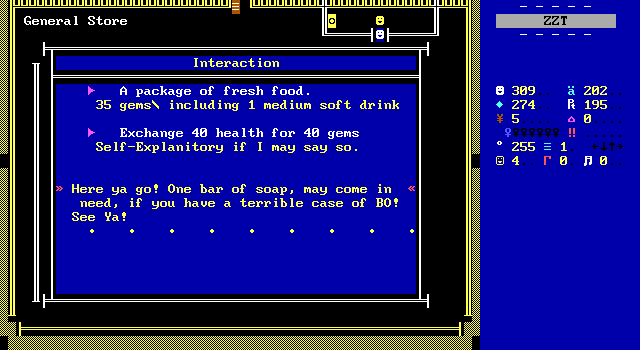
The one spot where there is any notable impact is at the general store. Here, the player auto buys soap when they interact with the shop-keep. For some reason, every single purchase option also locks the object, which means even if the labels worked as intended, you'd only be able to buy a single item. The unintentionally running code means that you only have one chance to buy any of the items.
In some games, this would be a major issue. In Captain Cosmo, the items for sale are soap which does nothing, ammo which has a typo with its label so it can't be purchased, food that does nothing, and an awkwardly worded trade where you spend gems for an equivalent amount of health (NOT selling your blood for cash). The food is notable as it also lacks an #END command, so purchasing it also does the health exchange.
So two options that aren't meant to do anything. One that doesn't work. One that does the opposite of what it sounds like it will do. It's a bit of a mess all around. Fortunately, supplies are very easy to come buy here, making it unnecessary to purchase additional health or stock up on ammo (the latter of which can't be done).
And lastly, to top it all off, none of the #TAKE commands have a fallback label for players that don't have enough money making it possible to buy anything you want even if you can't afford it.
All of this is pretty harmless. The shop doesn't matter enough, cash is found easily enough. The shop doesn't even work more than once, but it demonstrates that Sagen still has plenty to figure out before you'd call his games well-coded.
Final Thoughts
Captain Cosmo is a fine example of a game where you can feel the author learning as they go, but starting from somewhere that suggests this isn't their first time opening the editor. The game sprawls quite a bit, with ideas being added and discarded seemingly at random. The board order is all over the place, focusing on the VR arcade boards before the rest of the actual world outside of Cosmo's home. The planetarium shows up early, along with its unused side alley which also is thrown aside during normal gameplay.
Make it up as you go along is honestly a perfectly valid way to craft a ZZT adventure. In particular one that revolves around talking to people, exploring a town, and having the occasional laser duel with unscrupulous persons. There's no real structure to be had beyond the town serving as a hub. Players will enter a library and end up jumping into a swimming pool. A star ship captain walks into a bar... and then walks into the secret base of a guerrilla army of weirdos. No punchline.
It's not a a bad thing. The constant surprises of what you'll encounter next mean even the most pedestrian of buildings may offer something far more elaborate. The city is more based on reality than combat arenas labeled "City Hall", à la City of ZZT. Yet there's always a chance that maybe you will need to deal with a few ruffians wherever you go.
Sagen mostly trips up when it comes to filling up spaces with something other than power-ups and enemies. The interior spaces of a lot of buildings feel half-finished with empty space, empty objects, and just a lack of things for the player to interact with. I get the feeling Sagen would have had a better time making something more action focused, yet for whatever reason felt the game needed an elaborate town as a set piece to mark the start of Cosmo's cosmic adventure (pun intended). Whether he was trying to do something a little more complex, felt obligated to make a town as so many ZZT games start in towns, or something else entirely can't be said with confidence. I just feel as if Cosmo had so much of it hastily sealed away in order to release the game a.s.a.p., with Sagen hoping that an audience would provide the encouragement and motivation needed to finish it.
There are some actual problems with the game as well. The wrong starting board is an unfortunate and time-honored mistake to make in ZZT. The out of order dialog is a more novel issue, but it impacts so little that it's hard to even realize it's happening and not just another example of confusing ZZT dialog. Empty objects you can't interact with are a source of frustration. Hyperlinks with missing #end commands break things, but somehow none of these problems really matter. The game still lets you go where you need to, and the starting supplies are plenty to get through any combat.
Captain Cosmo has its appeal as a light exploration game with a hint of science fiction aspects to it. I wouldn't go out of my way to play it again, nor would I to suggest readers try it out for themselves as it is rather sparse, and needs a lot of arbitrary zapping to really take in everything the game actually has to offer. Sagen's other ZZT game, Adventure of Bob, shows a significant amount of improvement over the well-meaning Cosmo.
Here, Sagen is still figuring things out, while showing that has some solid ideas in his head. The forced promotion plot is a big departure from the usual damsel in distress story. The town that really feels like the player's home, where Cosmo is shown to have friends, and be a recognized part of the community make it so Cosmo feels like he actually lives in this town. It's a considerable departure from shooting and puzzle solving his way through it.
Sagen's got clear promise here that will eventually be realized in Adventure of Bob. As always, ZZT and game creation are a continuous learning process. These are humble beginnings that did lead to something more enjoyable, and without this half-baked first step, it's unlikely there ever would have been another. With Captain Cosmo, it's clear that Sagen's heart is in the right place. His #ends, however, are not.
